When choosing between natural and synthetic pH balancers, you've got to consider what suits your needs. Natural options, like apple cider vinegar or turmeric, are safe, eco-friendly, and improve health holistically, though they may lack precision. On the other hand, synthetic balancers, such as hydrochloric acid, offer accuracy but come with safety risks and potential side effects. If you want fast results, synthetic might be your go-to, while for sustainable wellness, natural options shine. Ultimately, recognizing your specific goals will guide your decision, and there's more to explore on how each can impact your health.
Key Takeaways
- Natural pH balancers are environmentally friendly and cost-effective but may require frequent adjustments for accuracy in pH measurement.
- Synthetic pH balancers offer precise and reliable results, making them suitable for professional settings despite their potential health risks.
- Natural remedies often involve additional health benefits, such as improving digestion, while synthetic options focus solely on pH control.
- The choice between natural and synthetic depends on the need for rapid results versus a sustainable approach to pH management.
- Safety precautions are essential when using synthetic balancers due to their corrosive nature and potential health hazards.
Understanding Ph Balance

pH balance is crucial for understanding how substances interact in various environments, whether in nature or laboratory settings. It's a measure of hydrogen ion concentration, with a neutral value of 7. When the pH drops below 7, you enter acidic territory, while values above 7 indicate alkalinity. You can measure pH using indicators that change color at specific pH levels.
Natural indicators, like turmeric and beetroot, derive from organic materials and can show color shifts, but they lack precision. They contain chromophores that react to pH changes, making them useful for educational purposes but not ideal for exact measurements. Additionally, natural alkaline water can be beneficial due to its unique chemical makeup and mineral content, which may not be present in artificial alternatives.
On the other hand, synthetic indicators like phenolphthalein and bromothymol blue are engineered for accuracy. They provide reliable color changes at specific pH ranges, making them the go-to for strong acid-strong base titrations.
While synthetic indicators generally outperform their natural counterparts in terms of accuracy and consistency, it's essential to consider the context of your experiment. Natural indicators offer an economical and eco-friendly option, but they're best suited for less precise applications.
Ultimately, understanding pH balance helps you choose the right tools for your needs.
Importance of Ph Balance

Maintaining a balanced pH is vital for overall health and well-being. An imbalanced pH can have serious health consequences, such as inflammation, fatigue, and increased risk of chronic diseases like heart attacks and diabetes.
When your body becomes too acidic, it may leach alkalizing minerals from your bones, leading to bone loss and a higher chance of fractures. Chronic acidosis can sap your energy and even encourage harmful yeast and fungi overgrowth. Chronic low pH can lead to systemic inflammation, which further increases the risk of developing diseases. To combat the effects of chronic acidosis and maintain healthy bones, it’s essential to incorporate alkalizing foods and practices into your diet and lifestyle. For instance, many fitness enthusiasts, including those following Zac Efron’s Iron Claw training regimen, emphasize the importance of a balanced diet rich in fruits and vegetables to support overall health and pH balance. By prioritizing nutrient-dense foods and staying hydrated, you can help mitigate the risks associated with acidity and promote stronger bone health.
Your diet plays a crucial role in maintaining this balance. Foods like meat and dairy can contribute to acidity, while fruits, vegetables, and certain seeds help alkalize your body. Incorporating green foods like spirulina and fresh lemons can also aid in balancing your pH, despite their initial acidity.
Additionally, your kidneys are essential in regulating your body's acid-base balance, and a balanced pH is crucial for preventing kidney stones and supporting bone health.
Consuming mineral-rich water and foods can help maintain alkalinity, ensuring your body functions optimally. By keeping your pH balanced, you protect yourself from various health issues and foster a healthier, more vibrant life.
Overview of Natural Balancers

Emphasizing the importance of a balanced body chemistry, natural pH balancers play a crucial role in promoting health and well-being. You can easily incorporate alkalizing foods into your diet, such as yams, sweet potatoes, and avocados.
Surprisingly, many fruits like lemons and tomatoes are also alkalizing, even though they taste acidic. Legumes, nuts, and seeds, including lentils and almonds, contribute to reducing acidity too.
Hydration is key; consider herbal teas like peppermint or refreshing green drinks made from vegetables. Apple cider vinegar, when diluted, can be a surprising ally in restoring pH balance. Alkaline water, with a pH between 9 and 11, is another great option. Incorporating less processed foods and whole foods contributes to pH balance.
Lifestyle choices matter as well. Reducing stress and engaging in deep breathing can help maintain pH balance. Staying hydrated, exercising regularly, and ensuring you get enough sleep are essential for your body's pH regulation.
Lastly, natural supplements like chlorella and digestive enzymes can support your efforts in balancing pH levels. By making these natural choices, you can foster a healthier, more balanced body chemistry.
Dietary Changes for Ph Balance

Making intentional dietary changes can significantly impact your body's pH balance and overall health. To maintain optimal skin pH, start by reducing your intake of high-sugar and dairy products, as these can disrupt your skin's natural acidic barrier. Additionally, incorporating flower teas into your routine can provide health benefits that contribute to overall wellness.
Instead, focus on incorporating foods rich in omega-3 fatty acids, like salmon and walnuts, which support skin health. Antioxidant-rich foods, such as berries and leafy greens, help combat oxidative stress that can alter your skin's pH. Additionally, consider that the effectiveness of certain foods as acid-base indicators can vary based on their pH range.
Stay hydrated, too. Proper water intake keeps your skin's barrier function intact, maintaining its natural pH. While drinking alkaline water may temporarily change your skin pH, your skin usually returns to its natural state.
Be mindful of the tap water you use for washing, as its higher pH can affect your skin. Aim for a balanced diet that includes both acidic and alkaline foods.
Citrus fruits and tomatoes can help maintain natural acidity, but don't forget the importance of essential vitamins and minerals. Remember, a diet low in fruits and vegetables can lead to imbalances, so prioritize these for healthier skin and better pH regulation.
Role of Probiotics
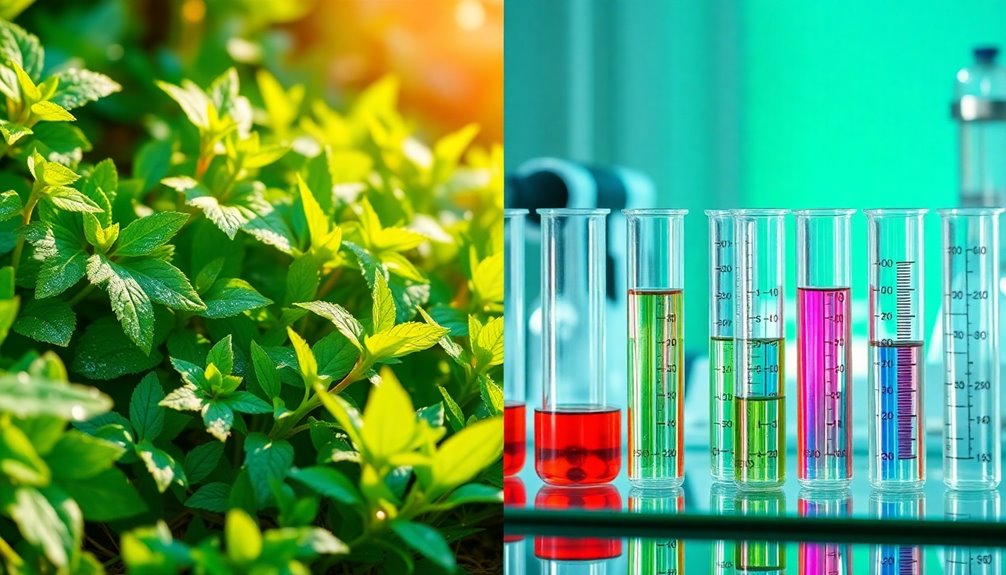
Achieving a balanced pH through dietary changes lays the groundwork for overall health, but probiotics play a significant role in maintaining that balance, especially in vaginal health. These beneficial bacteria help keep your vaginal pH level below 4.5, which is crucial for preventing infections and discomfort. Probiotics, such as *Lactobacillus crispatus* and *Lactobacillus rhamnosus*, support the growth of good bacteria, helping to alleviate symptoms of bacterial vaginosis and yeast infections. Additionally, many pH balance pills contain specific strains of lactobacilli, which can further enhance the benefits of probiotics. By restoring the balance of good and bad bacteria, probiotics prevent the overgrowth of harmful microorganisms. They also support the natural acidic environment of your vagina, reducing unusual odors and discomfort associated with pH imbalance.
You can take probiotics in capsule form, with or without food, and starting with a lower dose may help your body adjust. While probiotics are generally safe, it's essential to consult your doctor before adding them to your diet, particularly if you're pregnant. Keep in mind that not everyone may notice improvements, so monitoring for any adverse effects or interactions with medications is vital for your health journey.
Home Remedies Explained

Home remedies offer a natural approach to maintaining pH balance, especially when it comes to vaginal health. Ingredients like yogurt, apple cider vinegar, and coconut oil can help restore your body's natural acidity and promote a healthy environment. Moreover, essential oils like tea tree oil can also support vaginal health due to their antimicrobial properties.
Yogurt contains probiotics that can fight off harmful bacteria, while apple cider vinegar is known for its ability to balance pH levels due to its acetic acid content. Coconut oil, with its antifungal properties, can also provide relief from infections. Additionally, these natural remedies are often more practical and cost-effective than synthetic options, which are known for their greater stability in controlled applications.
Using these natural remedies isn't just effective; it's often more practical and cost-effective than synthetic options. You can easily prepare these remedies at home without the risk of harsh chemicals typically found in synthetic products. Unlike synthetic indicators that can cause health issues like rashes or cramps, these natural alternatives are generally non-toxic and safe to use. Plus, they're biodegradable, which means they're better for the environment.
While these home remedies can be beneficial, remember that results may vary. It's essential to listen to your body and consult a healthcare professional if you experience persistent issues. Embracing these natural solutions can be a step toward better pH balance and overall health.
Organic Supplement Options

Natural remedies can be an effective way to support pH balance, but incorporating organic supplements can further enhance your efforts. Probiotic strains play a crucial role in maintaining a healthy pH level. You might want to consider options like *Lactobacillus crispatus*, *Lactobacillus rhamnosus*, and *Lactobacillus acidophilus*. These specific strains are known to promote a balanced environment in your body.
In addition to these, other powerful probiotics like *Bifidobacterium lactis* and *Lactobacillus reuteri* can also be beneficial. When selecting an organic supplement, look for certifications that ensure the product is free from artificial colors, flavors, and preservatives. Research indicates that probiotics can aid in vaginal health, highlighting their importance in maintaining pH balance.
Many options are gluten-free and suitable for vegetarian or vegan diets, making them accessible for various lifestyles. For instance, products like AZO Complete Feminine Balance and Garden of Life Dr. Formulated Probiotics offer a range of CFUs to fit your needs.
If you're pregnant, rest assured that many of these options are safe for you as well. Integrating these organic supplements into your routine can significantly support your pH balance efforts.
Lifestyle Changes to Consider
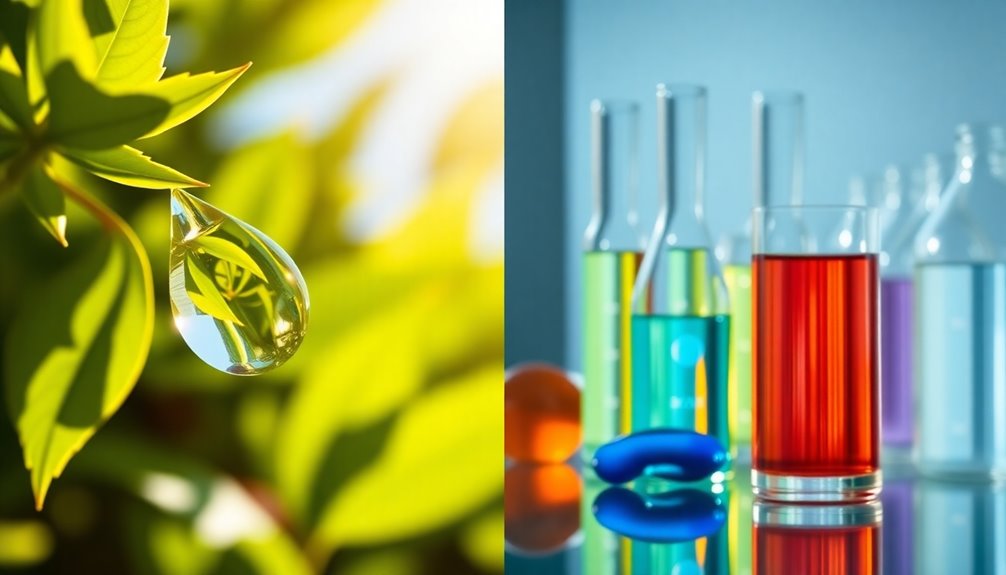
Making simple lifestyle changes can significantly enhance your pH balance. First, focus on your dietary habits by incorporating more nutrient-dense, alkalizing plant foods. Limit processed foods, as they can disrupt your pH levels. Aim to include raw or lightly cooked fruits and vegetables, which maintain crucial alkalizing minerals. Proper pH balance supports mineral retention and immune system function. Additionally, including chia seeds in your diet can provide essential nutrients that support overall health.
Don't forget to add superfoods like maca root, spirulina, and sea vegetables into your routine, and opt for healthy fats like coconut oil, MCT oil, and virgin olive oil.
Hydration is equally important; drink alkaline water with a pH between 9 to 11 to support balance. You can also increase the alkalinity of your water using pH drops or baking soda. Avoid distilled or reverse osmosis filtered water, which can be slightly acidic.
In addition to diet and hydration, practice good hygiene. Use sanitized products and avoid douching.
Manage stress and ensure you get enough sleep, as both can affect your body's pH. Lastly, consider the impact of your menstrual cycle or menopause on your pH levels, and consult with a healthcare professional if you have concerns about supplements or medications.
Food Choices for Balance

Choosing the right foods can significantly impact your body's pH balance. Incorporating natural indicators like turmeric, tomatoes, and beetroot into your diet can help you maintain this balance effectively.
Turmeric, with its curcumin content, isn't only a flavorful spice but also acts as a natural pH indicator. Beetroot juice and cherry juice both change color in response to pH levels, making them great choices for monitoring acidity. Foods that promote an acidic environment in the body can aid in maintaining a natural skin pH that is beneficial for overall skin health. Additionally, certain foods like coffee have been linked to improved cognitive function, which can further support overall well-being.
These foods have a similar efficiency to synthetic indicators, providing color changes at specific pH levels. This means you can achieve accurate end-point determinations in your dietary choices, much like in titrations.
Plus, natural indicators are easily accessible and cost-effective, making them practical options for everyday meals. Choosing these foods over synthetic alternatives is also healthier; natural indicators are non-toxic and safer for your body.
You won't have to worry about potential health issues that synthetic indicators can cause. By focusing on these fruits and vegetables, you not only support your body's pH balance but also contribute to a healthier, more environmentally friendly lifestyle.
Overview of Synthetic Balancers
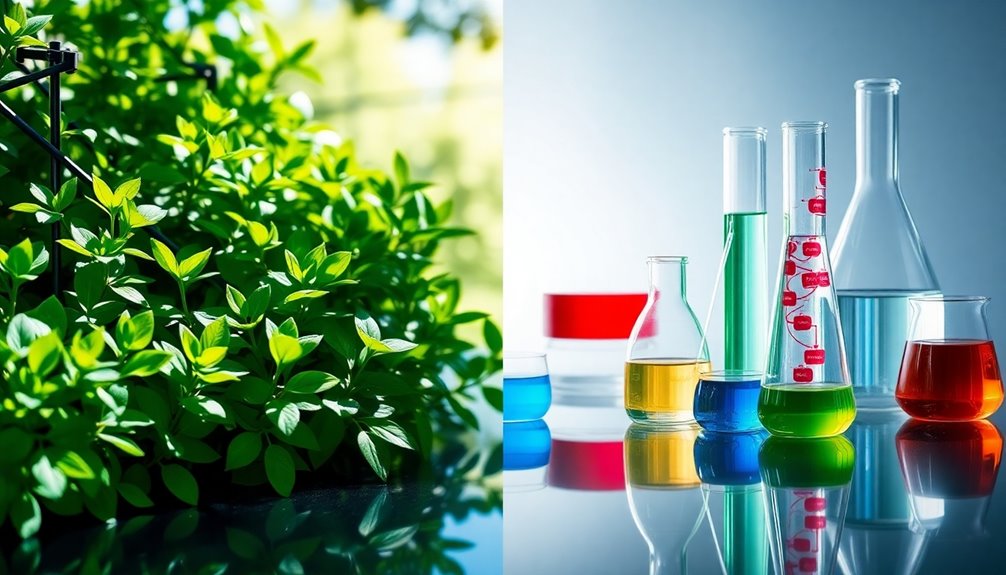
Synthetic pH balancers play a crucial role in various applications, particularly in industrial settings. One of the most common synthetic balancers is hydrochloric acid, also known as muriatic acid. This strong acid is effective in quickly lowering pH levels, making it essential for processes like chemical manufacturing and water treatment.
You'll find it widely used in pool maintenance, where precise pH control is necessary. When working with synthetic pH balancers, safety is paramount. Hydrochloric acid is highly corrosive and can damage surfaces, so it's vital to use appropriate protective gear, including gloves, eyewear, and sometimes masks.
Be aware that this acid completely dissociates in water, releasing hydrogen ions, which can lead to severe skin and eye irritation. In many cases, synthetic pH balancers can be more cost-effective than their natural counterparts, especially when large quantities are needed. However, proper storage and handling are crucial—always keep them in well-ventilated areas and away from children and pets. Having neutralization procedures ready for spills can help mitigate potential hazards.
Understanding these aspects ensures you can safely and effectively utilize synthetic pH balancers in your applications, especially considering their role in quickly lowering pH levels.
Pharmaceutical Treatments
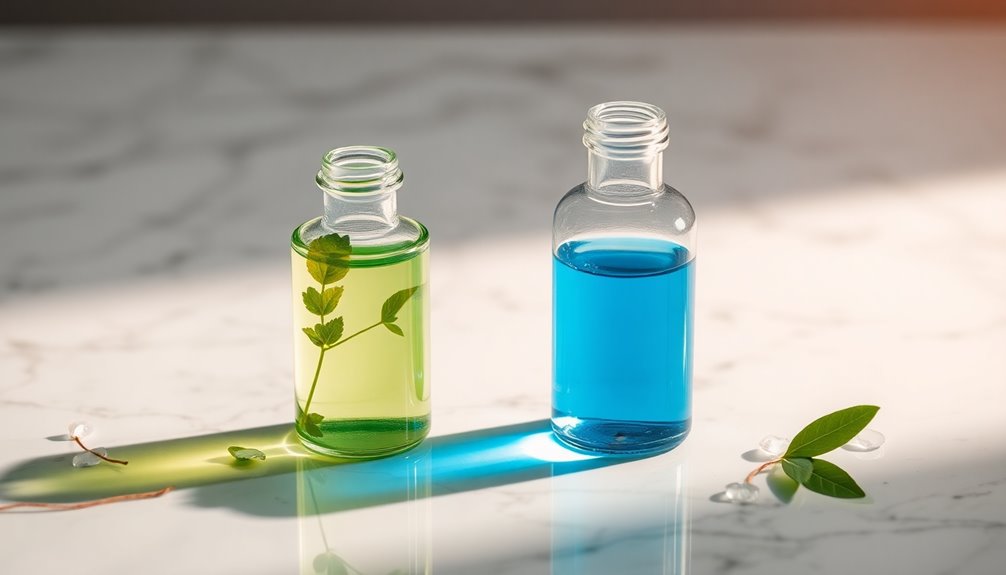
Natural pH indicators offer a practical and effective solution in pharmaceutical treatments, especially when precision is crucial. You'll find that these indicators, derived from readily available materials like turmeric, tomatoes, and beetroot, aren't only cost-effective but also environmentally friendly.
Turmeric, for instance, is easily accessible at local markets, making it a budget-friendly choice compared to synthetic alternatives.
In titration, natural indicators perform impressively, working effectively for both strong and weak acids. They display color changes that rival those of synthetic indicators like methyl orange and phenolphthalein. You can expect consistent endpoints during titration, and natural indicators maintain accuracy regardless of temperature variations.
They help determine molar and mass concentrations of acids and bases accurately.
Moreover, natural indicators pose fewer health risks, unlike synthetic options that can lead to issues like abdominal cramps and rashes. By opting for natural indicators, you also contribute to reducing environmental pollution.
Their efficiency is comparable to synthetic indicators, making them suitable for both educational settings and advanced applications. Natural indicators truly represent a safer, cost-effective choice in pharmaceutical treatments.
Non-Organic Probiotics

Probiotics, often referred to as "good bacteria," play a crucial role in maintaining gut health and enhancing overall well-being. You might've heard the term "non-organic probiotics," but it's a bit misleading. Probiotics are inherently biological and organic, derived from natural sources like fermented foods and the human gut. They consist of live microorganisms, primarily bacteria or yeast, that provide health benefits when consumed.
It's essential to understand that there are no synthetic probiotics. Instead, you'll find synthetic prebiotics or other non-probiotic supplements, which serve different purposes. While probiotics support gut health and immune function, they don't directly balance pH levels. Instead, they enhance the environment of your gut, which can indirectly influence body pH.
Unlike synthetic pH balancers like vinegar, which actively alter pH in various contexts, probiotics are non-toxic and biodegradable. They're tailored for biological systems, particularly in supporting your health. Additionally, engaging with educational toys enhances children's cognitive development, similar to how probiotics foster a healthy gut environment.
Commercial Product Insights
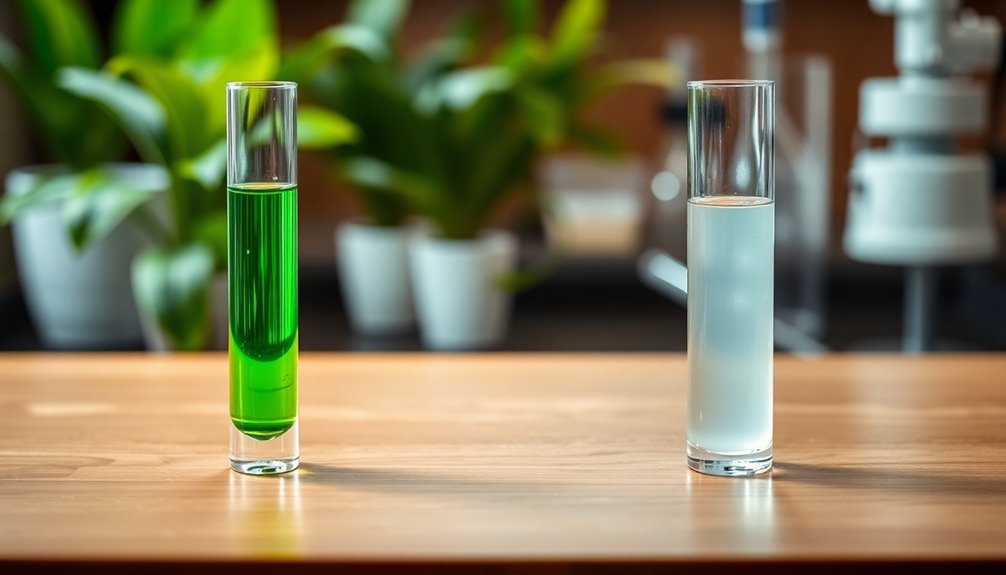
Understanding the differences between commercial pH indicators can significantly impact your choice for various applications.
Synthetic pH indicators like phenolphthalein and bromothymol blue are designed for accuracy, providing clear color changes at specific pH levels. They're reliable for strong acid-strong base titrations, making them the go-to option in professional and industrial settings. With defined pKa values, these indicators ensure precise endpoint determinations.
On the other hand, natural pH indicators, derived from materials like turmeric and beetroot, are often more cost-effective and environmentally friendly. They can be easily sourced and prepared locally, reducing your reliance on external supplies. While natural indicators can exhibit color changes, they may lack the precision of synthetic counterparts, making them better suited for educational purposes rather than critical industrial applications.
In practical terms, synthetic indicators dominate in industry due to their consistency and reliability.
However, natural indicators are gaining traction as viable alternatives, especially for educational use or when budget constraints are a factor. Your choice between synthetic and natural indicators ultimately depends on your specific needs, balancing cost, reliability, and environmental considerations.
Safety and Regulation Concerns
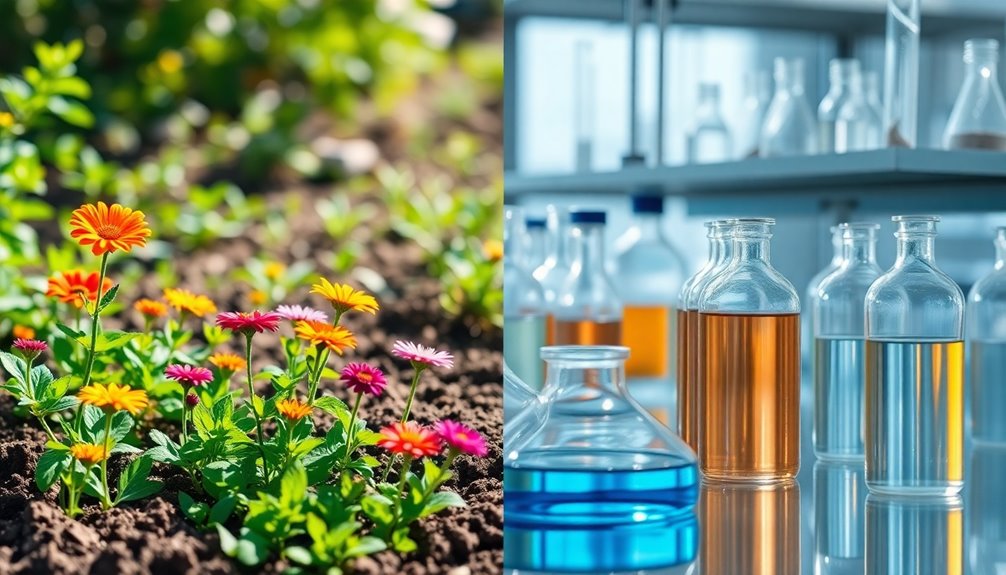
When it comes to safety and regulation concerns, synthetic pH balancers present significant challenges that you need to be aware of.
These products, like hydrochloric acid, can be highly reactive and require protective gear to prevent skin and eye damage. If mishandled, they can cause severe burns and respiratory problems. Additionally, improper storage and disposal can lead to dangerous accidents. Furthermore, the use of energy-efficient systems can help reduce the overall environmental impact of chemical usage in various applications.
Environmental impacts are another key concern. If not disposed of correctly, synthetic pH balancers can contaminate water bodies and soil, contributing to pollution that affects aquatic ecosystems. They are persistent in the environment and can disrupt natural pH balances, potentially violating environmental regulations.
From a health perspective, these balancers can lead to skin irritation, allergic reactions, and long-term health issues, including organ damage. They also lack the natural minerals found in naturally alkaline water, which could lead to mineral deficiencies in your body. Moreover, nutritional support is essential for high performers to maintain optimal health, highlighting the importance of choosing safer alternatives.
Regulatory oversight exists, requiring manufacturers to comply with safety regulations and provide clear labeling. However, mislabeling or inadequate disclosure can pose risks, leaving you unaware of the potential hazards associated with these synthetic products. Always stay informed about what you're using.
Effectiveness of Each Approach

Synthetic pH balancers may pose safety and environmental risks, but their effectiveness in achieving rapid results is often what makes them appealing.
You'll find that synthetic acids like hydrochloric acid can quickly lower pH levels, making them ideal for large-scale applications. Their high concentrations mean you need less product for immediate effects, offering you precise control over nutrient levels. This can be especially beneficial in industrial settings where consistency is key.
On the other hand, natural pH balancers, like vinegar, are more environmentally friendly and less likely to contaminate ecosystems. They can effectively adjust pH in various water systems, but they may require more frequent adjustments due to their milder nature. Recent research suggests that natural indicators like turmeric can show effective pH changes, demonstrating their potential as sustainable alternatives.
While natural options mightn't act as quickly, they provide a sustainable choice that supports organic practices.
Ultimately, if you seek rapid and precise control, synthetic options may suit your needs better. However, if you prioritize environmental safety and sustainability, natural balancers offer a viable alternative.
Consider your specific requirements to determine which approach works best for you.
Frequently Asked Questions
Can Ph Balance Affect Menstrual Cycle Regularity?
Yes, maintaining a balanced vaginal pH can impact your menstrual cycle regularity. An imbalance may lead to infections, which disrupts hormonal health and cycle patterns, so keeping your pH in check is essential for overall reproductive health.
How Long Does It Take to Notice Ph Balance Changes?
You'll typically notice pH balance changes within a few weeks to months, depending on the method you use. Regular monitoring and patience are key, as gradual adjustments often yield more sustainable results over time.
Are There Ph Balancing Options for Men?
No, there aren't specific pH balancing options for men. Instead, focus on maintaining overall health through a balanced diet, probiotics, and healthy lifestyle choices, which can support your body's natural pH balance effectively.
Can Stress Directly Impact Ph Levels?
Yes, stress can directly impact pH levels. Increased cortisol production boosts acidity, affecting your overall health. Managing stress through diet, exercise, and relaxation techniques can help maintain a healthier pH balance in your body.
Is There a Link Between Ph Balance and Skin Health?
Yes, there's a strong link between pH balance and your skin health. Maintaining balanced pH levels supports your skin barrier, reduces inflammation, and helps prevent conditions like acne and eczema, keeping your skin vibrant and healthy.
Conclusion
In conclusion, choosing between natural and synthetic pH balancers depends on your individual needs and preferences. Natural options, like dietary changes and probiotics, can offer holistic benefits without harsh chemicals. On the other hand, synthetic products might deliver quicker results but can raise safety concerns. Ultimately, it's essential to weigh the effectiveness and safety of each approach to find what works best for you. Trust your body, and don't hesitate to consult a professional for guidance.









